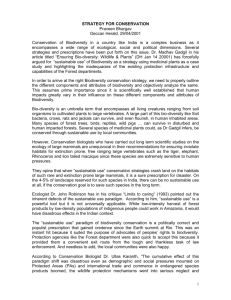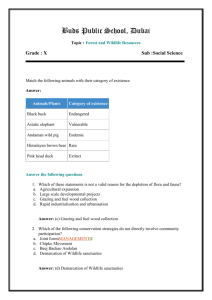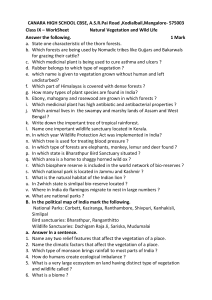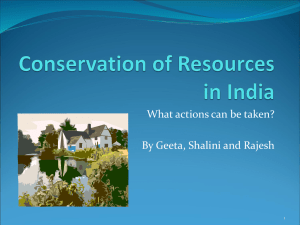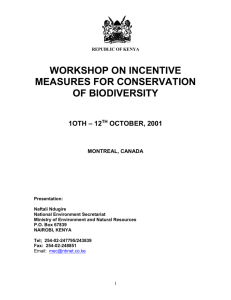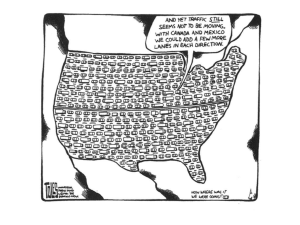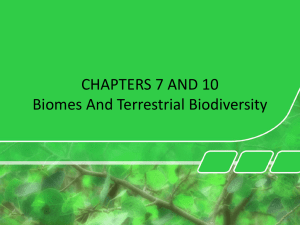Indian Language School Lesson-2 Forest and wildlife resources
advertisement
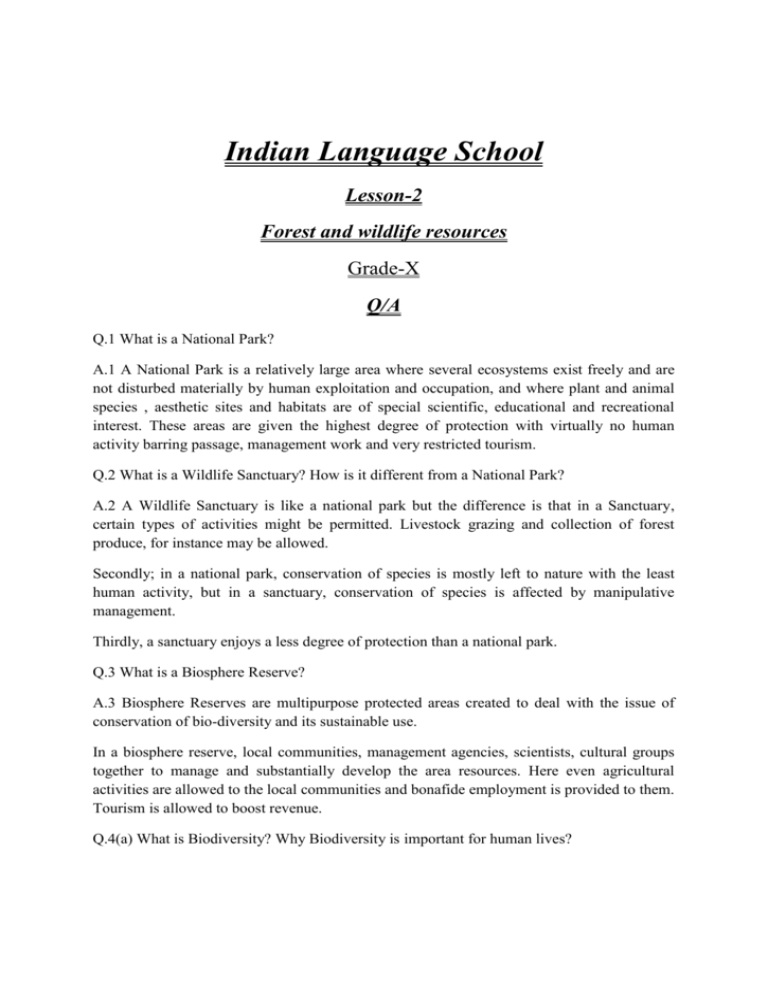
Indian Language School Lesson-2 Forest and wildlife resources Grade-X Q/A Q.1 What is a National Park? A.1 A National Park is a relatively large area where several ecosystems exist freely and are not disturbed materially by human exploitation and occupation, and where plant and animal species , aesthetic sites and habitats are of special scientific, educational and recreational interest. These areas are given the highest degree of protection with virtually no human activity barring passage, management work and very restricted tourism. Q.2 What is a Wildlife Sanctuary? How is it different from a National Park? A.2 A Wildlife Sanctuary is like a national park but the difference is that in a Sanctuary, certain types of activities might be permitted. Livestock grazing and collection of forest produce, for instance may be allowed. Secondly; in a national park, conservation of species is mostly left to nature with the least human activity, but in a sanctuary, conservation of species is affected by manipulative management. Thirdly, a sanctuary enjoys a less degree of protection than a national park. Q.3 What is a Biosphere Reserve? A.3 Biosphere Reserves are multipurpose protected areas created to deal with the issue of conservation of bio-diversity and its sustainable use. In a biosphere reserve, local communities, management agencies, scientists, cultural groups together to manage and substantially develop the area resources. Here even agricultural activities are allowed to the local communities and bonafide employment is provided to them. Tourism is allowed to boost revenue. Q.4(a) What is Biodiversity? Why Biodiversity is important for human lives? A.4(a) This entire habitat that we live in is immensely rich in wildlife and cultivated species, diverse in form and function but closely integrated in a system through multiple network of interdependencies. Importance i. ii. iii. Human beings depend on biodiversity for their very survival. Without plants & animals we cannot survive. Plants create the quality of air we breathe in. Q.4(b) How is India rich in biodiversity? A.4(b) India is one of the world’s richest countries in forms of its vast array of biological diversity. 2. It has nearly 8% of the total number of species in the world(estimated to be 1.6 million). 3.81,000 species of fauna are found in India. 4. It has 47,000 species of flora. 5. 15,000 flowering species are endemic(indigenous) to India. Q.5 Explain how human activities have affected the depletion of Flora & Fauna. A.5 (i) Humans have cleared the jungles for their own living and their animals as well as for the construction of their houses. Too much destruction of trees has disturbed the ecosystem and has created various health problems for themselves. (ii) The agricultural expansion during colonial rule and even after independence proved one of the major causes of the depletion of Flora & Fauna. (iii) The great demand for sleeper for the expansion of railways and ship building during the colonial rule also inflicted great damage to the Indian forests. (iv) As a result of the removal of the original plant cover and its replacement by a single crop, the biodiversity has been reduced and a single crop has become venerable to pests and diseases. (v) The burning of fossil fuel in large quantities , automobile exhausts, gaseous effluents from factories have led to the pollution of air & water. (vi) As a result of pollution of air & water, various species of plants have become extinct because pollution of air & water adversely affects plants. Q.6 Differentiate between kinds of species giving examples of each. A.6 Normal Species: 1.Species whose population levels are considered to be normal for their survival. 2.Eg:Cattle, sal, pine, rodents.etc. Endangered species: 1. These are species which are in danger of extinction. 2. Black buck, crocodile, Indian wild ass, Indian rhino, lion tailed macaque, sangai (brow anter deer in Manipur.)etc. Vulnerable Species 1. These are species whose population has declined to levels from where it is likely to move into the endangered category in the near future if the negative factors continue to operate. 2. Eg: Blue sheep, Asiatic elephant, Gangetic dolphin. Rare Species: 1.Species with small population may move into the endangered or vulnerable category if the negative factors affecting them continue to operate. 2.Eg:Himalayan brown luar, wild Asiatic buffalo, desert fox and hornbill.etc. Endemic Species: 1. These are species which are only found in some particular areas usually isolated by natural or geographical barriers. 2. Eg: Andaman teal, Nicobar pigeon, Andaman wild pig, mithun in Arunachal Pradesh. Extinct Species: 1. These are species which are not found after searches of known or likely areas where they may occur. 2. Eg: Asiatic cheetah, pink head duck. Q.7 Explain how there has been a great loss of biodiversity in India. Give three causes. A.7 The following data tells us why there is a loss of biodiversity:1. Half of India’s natural forests are gone. 2.One third of its wetlands drained out. 3.70% of its surface water bodies polluted. 4.40% of its mangroves wiped out. CAUSES:1.Habitat destruction:- The destruction of forests has destroyed the habitat of many species and reduce the flora and fauna of the country. 2. Hunting & Poaching:Hunting has endangered many species many species and led to the extinction of some. Despite the ban on hunting, poaching goes on and has killed many animals. 3. Environmental pollution by cities and industries as damaged the biodiversity. Poisoning of rivers by release of industrial effluents and sewage from cities kills aquatic life. 4. Differential sharing of responsibility for environmental well-being causes damage to biodiversity. 5. Over-population in the third world countries is often cited as a cause of environmental degradation. Q.8 The conservation projects are now focusing on biodiversity rather than on a few of its components. Explain. A.8 There is now a more intensive search for different conservation measures. Even insects are finding a place in conservation planning. 2. In the notification under wildlife act of 1980 and 1986, several hundred butterflies, moths, beetles, and one dragonfly have been added to the list of protected species. 3.In 1991, for the first time plants were also added to the list starting with six species. Q.9 What measures has the Government of India taken to conserve forest and wildlife ? A.9 The Indian Wildlife(Protection) Act was implemented in 1972, with various provisions for protecting habitats. 2.An all-India list of protected species was also published, The thrust of the programme was towards protecting the remaining population of certain endangered species. 3. Hunting was banned and legal protection given to their habitats and trade in wildlife was restricted. 4.Central and many state governments established national parks and wildlife sanctuaries. 5.The central government also announced several projects for protecting specific animals, which were gravely threatened, including the tiger, the one-horned rhino. These are the five measures taken by the government of India to conserve forest and wildlife. NOTE:- The following questions have been discussed in class from the geography textbook and the students were instructed to mark the answers in the book. Q.10 When we conduct a survey we do not differentiate between natural forests and plantations. Why should we differentiate? Q.11 Based on the IUCN, in how many categories can we classify the existing plant and animal species. Q.12 Discuss the causes for depletion of forests. Q.13 Write a short note on ‘Project Tiger’. Q.14 What factors are responsible for the depletion of tiger population. Q.15 Explain the three different categories of forests classified by the forest department. Mention the states where each one is found. Q.16 Describe how communities have conserved and protected the forests and wildlife in India. Q.17 How have cultural beliefs conserved forests in India? Q.18 Write a short note on the joint force management programme? Q.19 Why do we need to conserve our forests and wildlife? Q.20 How is biological loss of forest and wildlife co-related with loss of cultural diversity? OR ‘ The destruction of forest and wildlife is not just a biological issue’ Explain.
